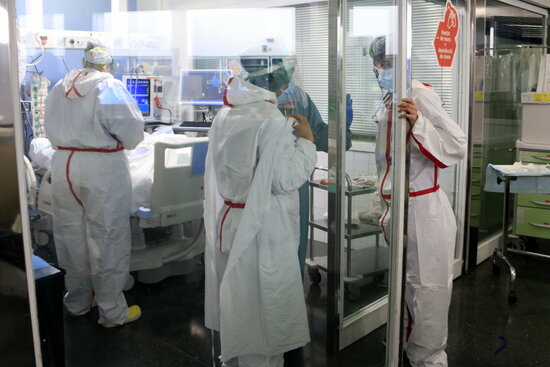Hospitals warn of ever-increasing ICU occupancy amid fourth pandemic wave
Covid-19 coordinators say metrics seen during low points between waves are getting increasingly higher

Catalan hospitals warn that ICU occupancy will fill up quickly if Covid-19 cases continue to increase, as is expected to happen in the coming days.
"We are starting from a bad situation with the forecast indicating it will get worse next week," the Covid-19 coordinator of the Hospital de Sant Pau, Pere Domingo, told the Catalan News Agency.
"We had never gone from one wave to another with a low point so high," explains Juan Pablo Horcajada of the Hospital del Mar, speaking about intensive care unit occupancy during the trough in between the third and current wave of the health crisis.
In the last two weeks, the number of patients in ICU beds in Catalonia due to Covid-19 has gone from 394 on March 26, to 498 on April 9.
During the lowest point after the second wave, there were 314 ICU patients, on December 23, while the peak of the third wave came on February 1 with 731.
Horcajada attributes the rise to the expansion of the British variant and the lifting of restrictions a few weeks ago.
For a number of weeks, the county-level lockdown had been lifted, allowing people to travel freely throughout Catalonia. However, authorities reverted this decision, and people are no longer able to leave their county of residence, a measure that will last until April 19 at least.
Hospital del Mar also detects that the average patient age is lowering too, with 25% under 50. Hospital Sant Pau does not see major changes in age at the moment, but they do say they are seeing members of the same family more often.
"Before Easter, we saw that the decline of hospitalizations had stopped,” says says Dr. Juan Pablo Horcajada, who goes on to explain that that point represented a very high trough in the long-term graph.
"This change in trend, coupled with the expected increase in indicators after the mobility of Easter, makes us think that we are already facing the fourth wave."
"The current situation is that we are growing and it is especially worrying in the ICU. When a patient is admitted, they do not stay there for days, but for weeks," Dr. Pere Domingo says.